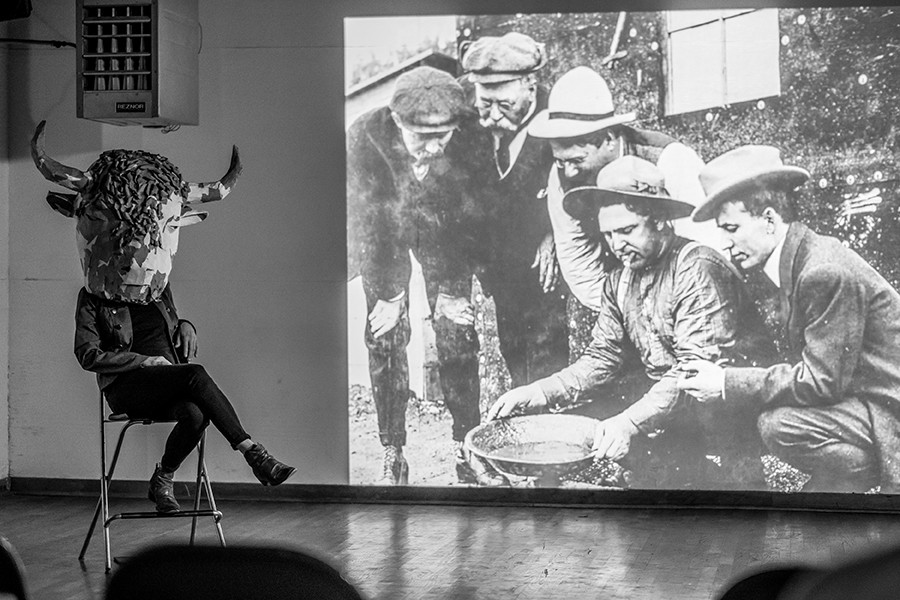
One day in 2012, Leyya Tawil donned goggles and proceeded to saw a big wooden dresser in half on the sidewalk in front of the Temescal Art Center (TAC). It was an act of healing catharsis. The dancer and TAC director hoped to usher in a new era for the venue. And it was performance, considering all of the onlookers. It also inspired a piece of hers called Destroy, which involves creating an expanded dance routine, usually with collaborators from other disciplines, and then somehow wrecking it through performance, all in one day. She’s since realized Destroy dozens of times on three continents.
Tawil, 42, recounted the origin of Destroy this past Saturday during a participatory history lesson at the TAC, part of a weekend-long 20th anniversary celebration for the unassuming, 800-square-foot arts space in a former garage just off Telegraph Avenue. Attendees added to a timeline on butcher paper taped to the wall and, like Tawil, shared how TAC debuted or nurtured their most left-field work. Linda Mac, partner of the late artist provocateur Frank Moore, whose nude “eroplay” events inflamed censors for decades, said that Moore referred to TAC as his “performance home.”
Located at 511 48th St., Temescal Art Center looks like a blank slate: one rectangular room with white walls and a sprung wooden floor, awaiting transformation. It’s a dance studio, a film salon, and an experimental music venue that fosters relationships across those media.
It’s also a little secretive. For the anniversary, Tawil made a glossy poster and TAC merchandise (a tote bag) for the first time in 20 years. “I had a visceral response to the branding, like, ew, I don’t want a logo,” Tawil told me. During the history talk, dancer and choreographer Isabelle Sjahsam attributed TAC’s longevity to this “veil of invisibility.”
Tawil moved to the neighborhood from Michigan in 1997, looking to continue her dance studies at Mills College, and discovered TAC via a flyer on a telephone pole. (It was actually founded by Leigh Evans as a yoga studio in 1994.) She described early public programming as a mix of action theater and modern dance, with a distinct butoh moment. In the Aughts came punk and avant-rock groups such as Sleepytime Gorilla Museum. But in 2009, complaints from new neighbors spurred a two-year noise-probation period.
Tawil said that, years ago, people had hardly heard of Temescal. The neighborhood has dramatically gentrified, she said, recalling when TAC’s neighbors were the charity thrift shop Clausen House (now Lanesplitter Pizza) and the post office (now condominiums). TAC looks pretty much the same, but it’s perceived differently by virtue of its name, she noted. “People hear ‘Temescal’ and ‘art,’ and they assume we must not need any support.”
Tawil became TAC’s sole director in 2012 and merged the venue with her nonprofit, Dance Elixir. Effectively a volunteer, she collects no salary; she says TAC subsists on earned income, mostly from performance rentals. (It’s a satellite studio for the Shawl-Anderson Dance Center.) Property ownership has changed repeatedly, but the rent has remained below market rate. Still, Tawil suspects that TAC’s new five-year lease will be its last. “This morning I got an email with the subject ‘noise,’ and it’s about our teen dance class on Wednesday afternoons,” she said. “That kind of thing scares me.”
In the meantime, TAC continues to provide a platform for underground artists. Its anniversary celebration reflected Tawil’s inroads with local experimental musicians. Friday’s program featured the enchanting vocals-and-percussion duo Voicehandler, whose drummer, Jacob Felix Heule, hosts a regular improvisation workshop at TAC. On Saturday was a performance by Gregory Scharpen’s ensemble Thomas Carnacki, whose rotating members often voice common objects such as, say, a candleholder or a bowl of sand. Thomas Carnacki debuted at TAC more than 10 years ago; most local venues it’s played since have disappeared.
Also on Saturday was a quartet led by drummer Jordan Glenn. The improvisers evinced great tactile sensitivity as they buzzed and clattered through an alternately surging and eddying piece. And then Dominic Cramp and Kelly Porter appeared as Lord Tang. Playing keyboard atop slinky beats, Cramp faced a projector that spilled animated paintings onto his white suit. Porter worked on a new canvas beside him. The vibrant colors combined with Cramp’s demented gestures to charge the whole room with a sort of funhouse terror.
“People have screamed and cried and laughed here for 20 years, and the remnants of that make this room feel how it feels,” said Tawil, adding that she took TAC for granted for a good decade. “What do we need in the next five years? I’ve never thought in those terms. But now that I’m looking backward I’m also starting to do the looking forward.”












